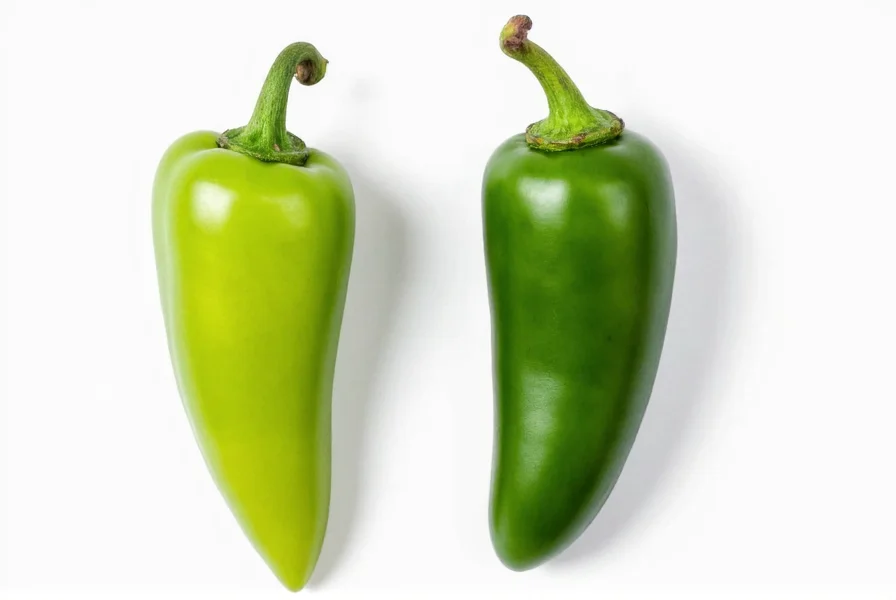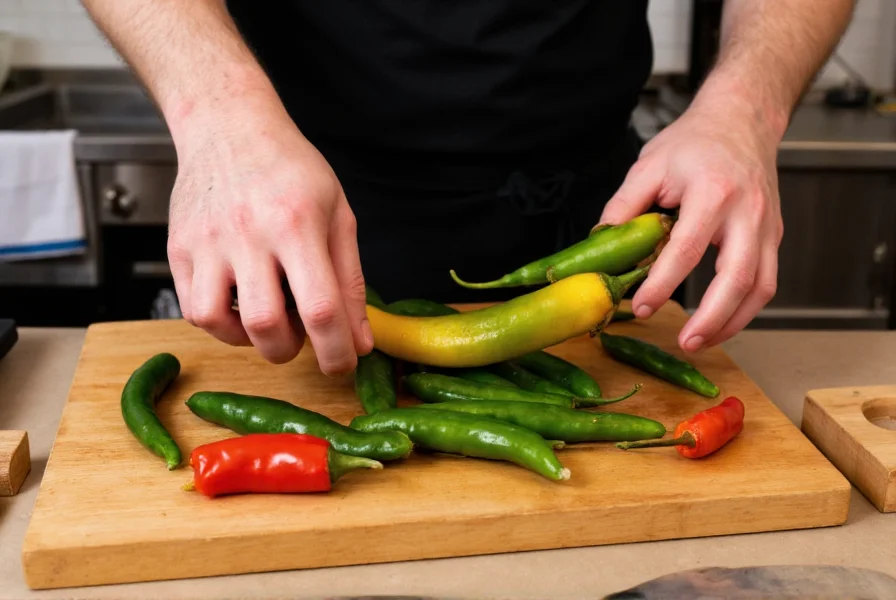When comparing serrano pepper vs jalapeño pepper, understanding their distinct characteristics helps home cooks and culinary enthusiasts make informed decisions for their recipes. Both belong to the Capsicum annuum species but offer unique heat levels, flavors, and culinary applications that significantly impact cooking results.
Heat Level Comparison: Understanding the Scoville Scale Differences
The most significant difference between serrano and jalapeño peppers lies in their heat intensity. Serrano peppers typically range from 10,000 to 23,000 Scoville Heat Units (SHU), making them two to five times hotter than jalapeños, which measure between 2,500 and 8,000 SHU. This substantial heat difference means serranos deliver a more immediate, intense burn that builds quickly, while jalapeños provide a milder, more gradual heat experience.
When working with these peppers, remember that heat concentration varies within each pepper. The placenta (white ribs and seeds) contains the highest concentration of capsaicin, so removing these parts reduces heat in both varieties. However, serranos maintain their superior heat level even when prepared identically to jalapeños.
| Pepper Type | Scoville Heat Units | Relative Heat Level | Heat Duration |
|---|---|---|---|
| Serrano Pepper | 10,000-23,000 SHU | High | Immediate, intense, shorter duration |
| Jalapeño Pepper | 2,500-8,000 SHU | Moderate | Gradual build, longer duration |
Physical Characteristics and Appearance
Serrano peppers measure 1-4 inches in length with a straighter, more tapered shape compared to the rounder, bulbous form of jalapeños, which typically reach 2-4 inches. Serranos grow upright on the plant, while jalapeños hang downward—a distinctive growing pattern that helps gardeners identify them.
Both peppers start green and mature to red, but serranos can also ripen to yellow, orange, or brown hues. The skin of serranos appears smoother and glossier, whereas jalapeños develop characteristic striations or stretch marks as they mature, particularly when grown in drier conditions.

Flavor Profiles Beyond Heat
While heat level often dominates the serrano pepper vs jalapeño pepper discussion, their flavor profiles offer equally important distinctions for culinary applications. Serranos deliver a bright, clean, slightly floral heat with grassy undertones, making them ideal for fresh salsas and sauces where pepper flavor should shine through. Their thinner walls contain less moisture, concentrating their flavor.
Jalapeños provide a more complex flavor profile with earthy, vegetal notes alongside their moderate heat. Their thicker walls and higher moisture content make them more versatile for stuffing, pickling, and roasting. When smoked, jalapeños become chipotles, developing a distinctive smoky-sweet flavor that serranos cannot replicate due to their thinner walls.
Culinary Applications and Recipe Considerations
Understanding when to use serrano vs jalapeño can transform your cooking. Serranos excel in fresh preparations like pico de gallo, salsa verde, and ceviche where their intense heat and bright flavor enhance without overwhelming. Their heat holds up well in cooked dishes like stews and braises, though prolonged cooking can mellow their distinctive flavor.
Jalapeños shine in applications requiring texture and versatility. They're perfect for jalapeño poppers, pickled jalapeños, and nacho toppings due to their thicker flesh. When substituting serranos for jalapeños in recipes, use approximately half the quantity to maintain similar heat levels. For those wondering can I substitute serrano for jalapeño in recipes, the answer is yes, but with careful heat adjustment.

Growing Characteristics for Home Gardeners
For gardeners comparing serrano pepper vs jalapeño pepper varieties, several growing differences matter. Serranos typically mature faster (70-80 days) than jalapeños (75-90 days) and produce more peppers per plant. They thrive in warmer conditions and require less water, making them suitable for drier climates.
Jalapeños are more forgiving for beginner gardeners, tolerating a wider range of soil conditions and temperature fluctuations. Both require full sun and well-draining soil, but jalapeños develop their characteristic striations when experiencing mild water stress, while serranos maintain their smooth appearance regardless of watering conditions.
Storage and Handling Tips
Proper storage extends the shelf life of both peppers. Store unwashed peppers in the crisper drawer of your refrigerator: jalapeños last 1-2 weeks, while serranos maintain quality for 2-3 weeks due to their lower moisture content. For longer storage, freeze whole peppers in airtight containers for up to 6 months—they'll lose crispness but retain flavor and heat for cooking.
When handling hot peppers, always wear gloves to prevent capsaicin transfer to sensitive areas. Never touch your face while preparing peppers, and wash hands thoroughly with soap and water afterward. If you experience burning, dairy products like milk or yogurt provide relief better than water, which spreads the capsaicin oil.
Substitution Guide for Recipe Success
Knowing how to substitute between these peppers ensures recipe success. When replacing jalapeños with serranos, use half the quantity called for in the recipe. For the reverse substitution (serranos with jalapeños), double the amount. Remember that this adjustment addresses heat level only—flavor differences will still affect the final dish.
For those seeking serrano pepper substitutes for jalapeño in specific applications: use fresno peppers for similar heat with comparable size, or guajillo peppers for dried applications. In fresh salsas where heat is primary concern, a combination of jalapeño and a small amount of cayenne pepper can approximate serrano's intensity.
Frequently Asked Questions
Which pepper is hotter, serrano or jalapeño?
Serrano peppers are significantly hotter than jalapeños, measuring 10,000-23,000 Scoville Heat Units compared to jalapeños' 2,500-8,000 SHU. Serranos typically deliver two to five times more heat than jalapeños, making them noticeably spicier in identical preparations.
Can I substitute serrano peppers for jalapeños in recipes?
Yes, but with adjustments. When substituting serranos for jalapeños, use approximately half the quantity to maintain similar heat levels. For the reverse substitution (jalapeños for serranos), double the amount. Remember that flavor differences will still affect the final dish, as serranos have brighter, more floral notes while jalapeños offer earthier, grassier flavors.
What are the main visual differences between serrano and jalapeño peppers?
Serrano peppers are smaller (1-4 inches), straighter, and more tapered with smooth, glossy skin. Jalapeños are larger (2-4 inches), rounder, and more bulbous with characteristic striations or stretch marks as they mature. Serranos grow upright on the plant while jalapeños hang downward, providing a clear visual distinction for gardeners.
Which pepper is better for making salsa?
The choice depends on your desired heat level. Serranos work best for hotter salsas like salsa verde where intense heat is desired, while jalapeños are preferable for milder table salsas. For authentic Mexican-style salsas where pepper flavor should shine through without overwhelming heat, serranos are often preferred by traditional cooks. For beginners or those sensitive to spice, jalapeños provide more forgiving results.
How do growing conditions affect the heat level of serrano and jalapeño peppers?
Both peppers develop more capsaicin (and thus more heat) when grown under stress conditions like limited water, higher temperatures, and nutrient-deficient soil. Serranos maintain their relative heat advantage regardless of conditions, but both varieties can vary significantly within their Scoville ranges based on growing environment. The same plant can produce peppers of varying heat levels throughout the season, with later harvests often being hotter.











 浙公网安备
33010002000092号
浙公网安备
33010002000092号 浙B2-20120091-4
浙B2-20120091-4